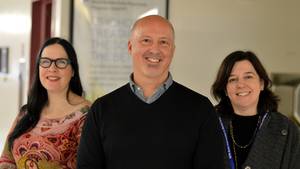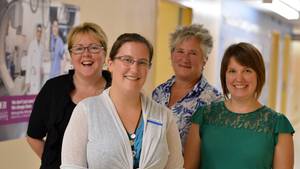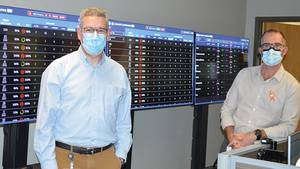Thanks to promising research in the field of vision loss conducted at the QEII Health Sciences Centre, we may be seeing further into the future than ever before.
Without this innovative research, the prevention of vision loss in an aging population would seem like a losing battle in today’s medical arena.
Because of age-related eye diseases, Atlantic Canadians find they are succumbing to the realities of getting older. But the QEII’s Eye Care Centre, a national leader in vision care, is collaborating with the Department of Medical Neuroscience at Dalhousie University, among others, to study the effects of aging on vision in hopes of developing new ways to detect, and treat, common eye ailments.
While some may find this a curious partnership, those involved quickly point out the logic behind the joint venture.
“A lot of the brain is devoted to vision,” says Dr. Alan Cruess, professor and head of the Department of Ophthalmology and Visual Sciences at DalhousieUniversity, as well as, District Chief of Ophthalmology at the QEII Health Sciences Centre.
“I like to think of the optic nerve as more of a white matter tract of the brain. Visual Science is really a subset of Neuroscience; we have cross-appointed neuroscientists, cross-appointed neurosurgeons, etc. Some of our neuroscientists actually prefer to study the retina because there are many opportunities to observe live neurons directly.”
Dr. Cruess says glaucoma and age-related macular degeneration (AMD) are the main aging diseases causing vision loss.
Glaucoma is a disease causing the deterioration of the optic nerve, usually due to pressure inside the eye. AMD is a loss of central vision, concerned with colour, face recognition and reading. This disease occurs when cells in the retina begin to break down.
Dr. Balwantray Chauhan Mathers, Professor of Ophthalmology and Visual Sciences, and research scientist at the QEII Health Science Centre specializing in the effects of glaucoma on vision, echoes Dr. Cruess’ support of studying the eye and brain together.
“The eye is really a unique organ. For those of us who work in vision, the eye is really an extension of the brain,” says Dr. Chauhan. “It’s the only part of the brain that you can directly image without cutting something open.”
Dr. Chauhan adds that another of the most treatable forms of age-related vision loss is cataract.
“The lens of the eye, with age, becomes a little bit stiffer and it also becomes more opaque,” says Dr. Chauhan. “Practically every individual will have a cataract at some point and will have that cataract removed and replaced with a plastic lens.”
While these are all well-known ailments, there are still a lot of questions, making continued eye research crucial. Armed with recent funding from the Atlantic Innovation Fund, an initiative through which the Government of Canada is making investments in research and development in Atlantic Canada, Dr. Chauhan says he and the research team have their sights set high.
“With all the advances in imaging technology, faster computational times, etc., we now have a fantastic opportunity to see things in the eye that we’ve never been able to see before,” adds Dr. Chauhan. “One of the things that we are trying to do is be able to visualize individual cells in the retina, and to be able to then monitor them in health and disease. Our objective over the next five years is to develop a prototype device that will allow us to do this.”
Both Dr. Chauhan and Dr. Cruess agree innovative research, such as their own, will help our population prosper into old age, and we’ll be able to see it happen much more clearly.







